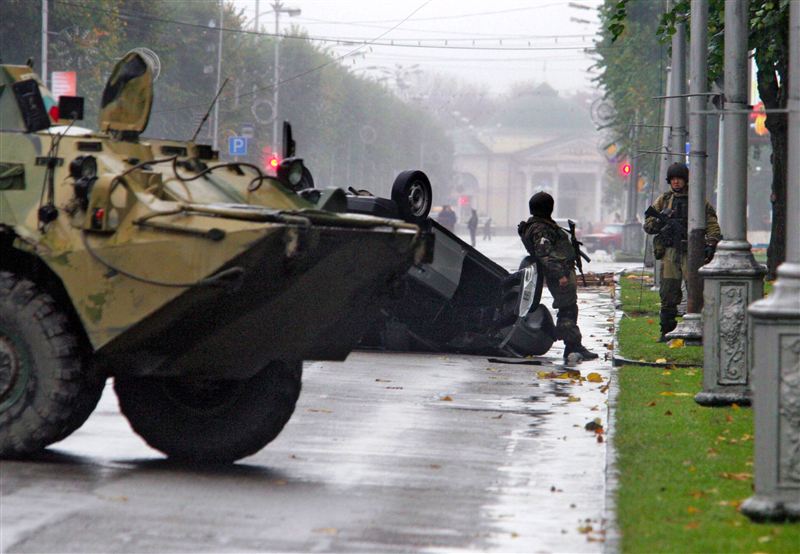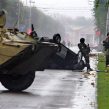
Wave of Destabilization Swept Kabardino-Balkaria in 2010 (Part One)
Publication: Eurasia Daily Monitor Volume: 8 Issue: 11
By:

On December 31, 2010, an Israeli analyst of the situation in Kabardino-Balkaria, Abraham Shmulevich, declared that the republic was entering a state of civil war. This stark warning came after a well-known researcher and popularizer of Circassian traditions and rites, Aslan Tsipinov, was killed on the doorsteps of his home on December 29. Two weeks earlier, on December 15, the republic’s mufti, Anas Pshikhachev, was killed in a similar fashion. As the police in the republic appear to be actually curtailing their presence, especially at night, fears are rising that the next step in Kabardino-Balkaria might be an open civil war between the Islamists and secular nationalists, the latter propped up by Moscow (www.caucasustimes.com, December 31, 2010). The young Islamist leader Emir Zakaria (aka Ratmir Shameyev) confirmed that the insurgency would now target not only government officials and the police, but also all “infidels,” “traitors of the faith” and “pagans” (www.islamdin.com, January 8, 2011). This is a very broad definition of “legitimate” targets, which essentially allows the Islamists to attack the vast majority of the republican population.
On January 13, several Kabardino-Balkarian civil organizations with ties to the government called for government authorities to defend the people against the perceived threat by the Islamists. Curiously, the address emphasized the importance of ethnic identity for successfully combating the jihadist ideology (www.kavkaz-uzel.ru, January 13). The next day, on January 14, the President of Kabardino-Balkaria, Arsen Kanokov, stated rather inconclusively that the government would hold the insurgents’ clan and family members responsible for suppressing the rebels’ activities (Interfax, January 14). The practice of collective punishment worked in Chechnya to some extent, but may be much less effective in Kabardino-Balkaria. First of all, traditional clans are much weaker in that republic than in Chechnya and, secondly, the republic did not experience a large-scale war that would allow the government to justify extreme actions of that kind.
It is hard to believe now that up until the spring of 2010 the situation in Kabardino-Balkaria was relatively quiet. According to the Kavkazsky Uzel (Caucasian Knot) website, which closely monitors the situation in the North Caucasus, there were 12 attacks in Kabardino-Balkaria in 2009, with the government and insurgents suffering four casualties each, while in 2010 there were nearly 100 attacks in the republic, with 22 government officers and 20 insurgents killed in fighting. In addition, 15 civilians or people with unclear affiliations were killed in 2010. The bulk of the attacks occurred in the republic’s principal city of Nalchik and the nearby town of Baksan. The security situation in Kabardino-Balkaria deteriorated so rapidly that it quickly reached a degree that rebels in other long time unstable regions of the North Caucasus had not been able to reach. On July 21, 2010, for the first time in the North Caucasus, an important infrastructure site, the Baksan hydroelectric plant, was attacked and rendered unusable. Before that, on July 11, as many as five transmitters were blown up in just four hours (https://www.kavkaz-uzel.ru/articles/172027/).
The downward spiral in Kabardino-Balkaria accelerated following the killing of the rebels’ leader, Anzor Astemirov (aka Emir Seifullah), on March 24. Astemirov reportedly had adopted an insurgent strategy of keeping a low profile in order to prevent a large-scale incursion of Russian armed forces into the republic which he feared would create the utter destruction of the republic, as it had in Chechnya.
Meanwhile, Kabardinian and Balkar activists clashed throughout 2010, arguing about land ownership, which still provides subsistence for many households. The Kabardinians (aka Circassians) comprise about 55 percent of the republic’s population and the Balkars, who speak a Turkic language, make up 12 percent of the population. The Balkars occupy the mountainous areas, including lucrative tourist destinations around Mount Elbrus. Balkar activists launched several hunger strikes, while the Kabardinians pressed ahead with stripping the Balkar villages of their “extra” pastures (www.kavkaz-uzel.ru, January 12). The issue was so hotly contested that at one point, Moscow’s envoy to the North Caucasus, Aleksandr Khloponin, even stated that it was “under the personal control of the president of Russia” (www.kavkaz-uzel.ru, July 23, 2010).
Despite the dramatic deterioration of the situation in Kabardino-Balkaria in 2010, President Dmitry Medvedev reappointed Arsen Kanokov as the head of the republic in September 2010. Prior to his reappointment, Kanokov and Khloponin had complained that unspecified forces were purposefully destabilizing the republic to cast doubt on Kanokov’s ability to lead the republic (www.kavkaz-uzel.ru, July 22, 2010). However, more than four months after Kanokov’s reappointment, the situation in the republic remains just as volatile. On January 15, unknown assailants gunned down a local policeman in the village of Islamei in Baksan district. On January 13, a local businessman was killed in the same village for refusing to pay off the rebels (www.kavkaz-uzel.ru, January 15). On January 3 a healer was killed in another village in the republic. The Islamists regard non-conventional medical practice as “witchcraft” and have promised to fight against it (www.kavkaz-uzel.ru, January 11).
Karachaevo-Cherkessia, located to the west of Kabardino-Balkaria, has the opposite ethnic make up. The Turkic-speaking Karachays, who are closely related to the Balkars, comprise the majority, while the Cherkess (Circassians) are a minority in this republic. It is important to note that the insurgents view Kabardino-Balkaria and Karachaevo-Cherkessia as a single territorial entity within the Caucasus Emirate, called “The United Velayat of Kabarda, Balkaria and Karachay,” or KBK. Even though Karachaevo-Cherkessia was comparatively quiet in 2010, at least two killings shook the republic. On March 14, an activist with the Cherkess youth organization, Aslan Zhukov, was killed near his home (www.aheku.org, March 14, 2010). On May 12, an adviser to the President of Karachaevo-Cherkessia and possible Cherkess candidate for the republican prime minister’s position, Fral Shebzukhov, was assassinated in Cherkessk (www.kavkaz-uzel.ru, May 12, 2010). Galvanized by these killings as well as other events, the Circassians of Karachaevo-Cherkessia demanded the creation of a separate autonomous region within the borders of the Russian Federation at an extraordinary meeting on June 5, 2010 (www.kavkaz-uzel.ru, June 5, 2010).
The nationalist uprising in Moscow in December 2010, when crowds of Russian nationalists staged pogroms in the Russian capital against those with North Caucasian or Asian appearance, intimately touched Kabardino-Balkaria. Aslan Cherkesov, who is accused of killing a Russian soccer fan and triggering the clashes in Moscow, comes from Kabardino-Balkaria. The anti-Caucasian protests in Moscow received a cool response not only among the ordinary people in Kabardino-Balkaria, but even in the local government where the local leadership differs with the Kremlin. Kanokov, for example, equated the Russian nationalists with the Islamic rebels in the North Caucasus, while the Russian leadership in Moscow adopted a much more conciliatory tone toward the Russian extremists.
Having displayed a particularly precipitous deterioration of the security situation, Kabardino-Balkaria is likely to deliver more surprises in 2011. So far, the Russian and local authorities have indicated little resolve or strategy to improve the situation in this republic. This combination leaves the republic in the most uncertain state it has experienced in recent years.




